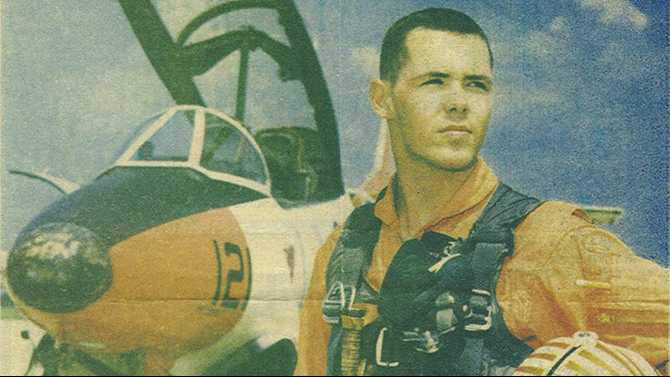This is the first of a two-part series on Jim Lawrence. A story exploring Lawrence’s trial by fire will run in the Sept. 7 edition of The News.
In 1965, the U.S. Navy graduated its last class of student aviators who didn’t own the sheepskin of a college degree. One class member was 19-year-old Jim Lawrence.
With the last name of Lawrence, his fellow cadets connected Lawrence with the World War I British nomad T.E. Lawrence, “Lawrence of Arabia.” Consequently, Jim’s lifelong call sign: NOMAD.
Jim Lawrence was born and raised in Jackson, Miss. He recalled, “I fell in love with aviation at a young age. When I was 6 years old, my father would drop me off at the local airport to watch airplanes take off and land all day long.”
By age 9, Lawrence was working at the airport, washing and cleaning airplanes. He soloed on his 16th birthday. While still in high school, Lawrence would fly to the Beechcraft plant in Wichita, Kan., and ferry new aircraft within the continental United States. Still a junior in high school, Lawrence joined the Marine Reserves. During his first semester at Florida State University, Lawrence was accepted by the Navy for Marine aviation. Hence, Jim Lawrence became Nomad.
Nomad admitted, “I had 40 hours in a T-34 before Pensacola, but I didn’t tell my flight instructors.”
On the day of his initial training flight, Nomad was asked if he had any questions. He replied, “No, sir.” On the tarmac his instructor asked if he wanted to start and taxi the Mentor. Nomad replied, “Yes, sir.”
Asked if he wanted to attempt takeoff, again Nomad said, “Yes, sir.”
Asked if he wanted to attempt a landing and perform a couple of touch and goes, Nomad said, “Yes, sir.”
From the back seat the instructor muttered, “damn,” then fell silent for the balance of the flight.
Back on the tarmac, Nomad was beaming a cocky smile as he scrambled from the Mentor. The discomfited instructor asked grumpily, “Have you flown previously?’’
Nomad said, “Well, I, uh…….”
The instructor blared, “We have a war going on and we need pilots!”
Nomad soloed the next day. Out of 722 students he was No. 1, a Top Gun.
With the full approval of a three-star admiral, Nomad was placed in the “Jet Pipeline” and sent to VT-7 at McCain Field in Meridian, Miss.
At 19, Jim “Nomad’’ Lawrence was training to become a fighter jockey.
At Meridian, Nomad mastered the T28 North American Buckeye with very little effort, then returned to Pensacola for a decisive phase of training: landing on an aircraft carrier. Nomad recalled, “Our carrier was the USS Lexington from World War II. She’d been modified with an angle deck and was waiting for us in the Gulf of Mexico. Up-close the Lexington is a huge ship, but approaching in a jet for your first carrier landing, she looked like a pencil. You’re behind the controls of the jet, thinking, ‘Holy cow! I’m supposed to land on that?’”
Nomad’s narrative of his first carrier landing goes like this:
“Carrier pilots don’t stall their planes to land; they actually fly into the deck. The second you hit the deck, you firewall the throttle (shove to full speed) in case you missed the hook; that way, you have the power for a go-around.
“Carrier pilots are continuously making changes for a landing, adjusting for wind and the proper glide path. Then I got the word, ‘Drop your hook,’ and I’m going, ‘Holy Cow! I’m 19 years old and landing on an aircraft carrier!’”
“I caught the third wire, but there was no time to gloat, because my buddy was 20 seconds behind me, so I had to follow my instructions from the deck crew.
“You see, the catapult’s steam pressure is predicated on the weight of your aircraft. Since you know the weight of your plane, the next thing to know is your fuel level, then calculate the proper weight.
“My weight was OK, so I’m hooked up to the shuttle. And I’m going, ‘Holy cow! I’m being catapulted off a real aircraft carrier!’”
“So I’m watching the Cat Officer on the front of the ship. He signals me to rev full power; I throttle up, glance at the Cat Officer and offer the traditional salute, basically saying, ‘Let’s do this.’
“I shove my head into the headrest, and then experience one of the coolest feelings in the world; just before launch, the airplane actually squats from the tension. I hold onto the handle, and then whoooosh; I go from 0 to 140 in 1.9 seconds. Let me describe the sensation: absolutely exhilarating!
Nomad flew advanced jets in Kingsville, Texas. With the Vietnam War in serious escalation, training was cut from 20 to 15 weeks. Earning his wings, Nomad served on the USS Independence in the Mediterranean before receiving orders for Vietnam.
Assigned to a hotbed of North Vietnamese activity south of Da Nang at Chu Lai, Nomad controlled the stick of an A-4 Skyhawk to give close air support to leathernecks on the ground.
Pete Mecca is a Vietnam veteran, columnist and writer. Reach him at aveteransstory@gmail.com or aveteransstory.us.




